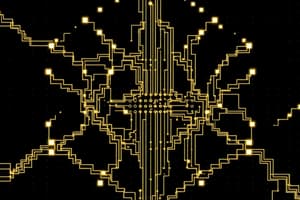Podcast
Questions and Answers
What is required for an automaton to assure system autonomy according to the theory discussed?
What is required for an automaton to assure system autonomy according to the theory discussed?
- Only physical execution rules
- A method for random generation
- A description of the environment
- An entity to interpret its own description (correct)
Which model is associated with the concept of self-reproduction in cellular automata?
Which model is associated with the concept of self-reproduction in cellular automata?
- Wolfram's classification
- Turing's model
- von Neumann's model (correct)
- Minsky's framework
In the context of cellular automata, what does Φ(X) represent?
In the context of cellular automata, what does Φ(X) represent?
- The external environment's influence
- The randomness of the state changes
- The description of an automaton (correct)
- The input configuration for the automaton
What paradox arises in the discussion of cellular automata and reproduction?
What paradox arises in the discussion of cellular automata and reproduction?
Which aspect is NOT directly mentioned as necessary for an automaton to interpret its own description?
Which aspect is NOT directly mentioned as necessary for an automaton to interpret its own description?
What role does automaton C play in the reproduction process?
What role does automaton C play in the reproduction process?
In von Neumann's model, how many times does automaton B copy the description?
In von Neumann's model, how many times does automaton B copy the description?
Which automaton is responsible for creating new automata from their descriptions?
Which automaton is responsible for creating new automata from their descriptions?
What does the joint description Φ(A, B, C) represent in the context of cellular automata?
What does the joint description Φ(A, B, C) represent in the context of cellular automata?
What happens to one of the copies made by automaton B after it is created?
What happens to one of the copies made by automaton B after it is created?
What is the main purpose of von Neumann's model in Cellular Automata?
What is the main purpose of von Neumann's model in Cellular Automata?
What does the spatial organization in Cellular Automata refer to?
What does the spatial organization in Cellular Automata refer to?
Which of the following statements about Cellular Automata is true?
Which of the following statements about Cellular Automata is true?
In Cellular Automata, what is a cell composed of?
In Cellular Automata, what is a cell composed of?
What is a key feature of Cellular Automata that relates to computation?
What is a key feature of Cellular Automata that relates to computation?
Which idea is central to understanding the function of Cellular Automata?
Which idea is central to understanding the function of Cellular Automata?
What kind of phenomena can Cellular Automata model effectively?
What kind of phenomena can Cellular Automata model effectively?
What is the relationship between input and output in a Cellular Automaton?
What is the relationship between input and output in a Cellular Automaton?
What is the primary impact of mutations in Cellular Automata (CA) systems?
What is the primary impact of mutations in Cellular Automata (CA) systems?
Which characteristic is essential for locality in Cellular Automata?
Which characteristic is essential for locality in Cellular Automata?
Which of the following statements correctly describes Class III behavior in Wolfram's classification of Cellular Automata?
Which of the following statements correctly describes Class III behavior in Wolfram's classification of Cellular Automata?
In the 1D Cellular Automaton model, how many possible transition functions can be defined?
In the 1D Cellular Automaton model, how many possible transition functions can be defined?
What is the defining rule for a cell to be considered 'alive' in Conway's Game of Life?
What is the defining rule for a cell to be considered 'alive' in Conway's Game of Life?
Which neighborhood type is used in the Game of Life?
Which neighborhood type is used in the Game of Life?
What is a common property of all Cellular Automata?
What is a common property of all Cellular Automata?
Which of the following describes a system with chaotic behavior in Cellular Automata?
Which of the following describes a system with chaotic behavior in Cellular Automata?
Which updating procedure allows cells to be updated based on random or fixed sequences?
Which updating procedure allows cells to be updated based on random or fixed sequences?
What is a key feature of a Class IV Cellular Automaton?
What is a key feature of a Class IV Cellular Automaton?
What is the relationship between the transmission function and neighborhood in Cellular Automata?
What is the relationship between the transmission function and neighborhood in Cellular Automata?
In the context of Cellular Automata, what does uniformity mean?
In the context of Cellular Automata, what does uniformity mean?
What is meant by the term 'survival' in the rules of the Game of Life?
What is meant by the term 'survival' in the rules of the Game of Life?
Which parameter does NOT characterize a one-dimensional Cellular Automaton?
Which parameter does NOT characterize a one-dimensional Cellular Automaton?
Flashcards
Cellular Automata (CA)
Cellular Automata (CA)
A model of computation consisting of a grid of cells, each with a state, where each cell's state evolves based on the states of its neighbors.
Universal Turing Machine
Universal Turing Machine
A mathematical abstraction of a computer that can perform any computation that can be performed by a Turing machine.
Cellular Automata
Cellular Automata
A dynamic system composed of a set of identical finite state machines arranged in a regular spatial lattice.
Neighborhood
Neighborhood
Signup and view all the flashcards
Cellular Automata
Cellular Automata
Signup and view all the flashcards
Life
Life
Signup and view all the flashcards
Reproduction
Reproduction
Signup and view all the flashcards
Universal Constructor
Universal Constructor
Signup and view all the flashcards
Theory of Reproduction
Theory of Reproduction
Signup and view all the flashcards
Von Neumann's Model
Von Neumann's Model
Signup and view all the flashcards
Reproduction Paradox
Reproduction Paradox
Signup and view all the flashcards
Self-Interpretable System
Self-Interpretable System
Signup and view all the flashcards
Automaton A
Automaton A
Signup and view all the flashcards
Automaton B
Automaton B
Signup and view all the flashcards
Automaton C
Automaton C
Signup and view all the flashcards
Φ(A, B, C)
Φ(A, B, C)
Signup and view all the flashcards
Reproduction in CA
Reproduction in CA
Signup and view all the flashcards
Life game
Life game
Signup and view all the flashcards
Totalising rule
Totalising rule
Signup and view all the flashcards
Number of states (k)
Number of states (k)
Signup and view all the flashcards
Dimension (d)
Dimension (d)
Signup and view all the flashcards
Neighborhood geometry
Neighborhood geometry
Signup and view all the flashcards
Neighborhood radius (r)
Neighborhood radius (r)
Signup and view all the flashcards
Transition function
Transition function
Signup and view all the flashcards
Synchronous updating
Synchronous updating
Signup and view all the flashcards
Homogeneous or Fixed Point - Class I
Homogeneous or Fixed Point - Class I
Signup and view all the flashcards
Heterogeneous or Periodic - Class II
Heterogeneous or Periodic - Class II
Signup and view all the flashcards
Chaotic - Class III
Chaotic - Class III
Signup and view all the flashcards
Complex - Class IV
Complex - Class IV
Signup and view all the flashcards
Study Notes
Cellular Automata
- Cellular automata (CA) are infinite sets of finite automata with spatial organization.
- Proposed in approximately 1950 by von Neumann and Ulam to model biological reproduction.
- A CA is a state machine with a transition function.
- The space is divided into identical elements (cells) with a geometry, defining a neighbourhood.
- Each cell has a finite automaton.
- Input: States of neighboring automata.
- Output: Automaton state.
- Temporal evolution of CA displays successive states of all cells.
Terminology
-
Finite automaton → transition function
-
State machine
-
Spatial organization → space division in identical elements with a geometry
-
Neighbourhood → the spatial element and finite automaton = one cell
-
Input → states of neighboring automata
-
Output → automaton state
-
Temporal evolution of CA → successive states of all cells
Properties and Applications
- CAs are capable of universal computation.
- Interesting for modeling spatial collective phenomena: fluid dynamics, diffusion and equilibrium, and forest fires.
- Useful for direct visual observation
A Theory of Reproduction
- If X is an automaton, and φ(X) its description: An automaton A is needed to interpret the description and build a new X.
- But... to ensure autonomy, A would need φ(A) and to interpret its own description.
- Paradox: The entity to make copies of descriptions is still needed.
- The complete self-replicating system comprises three automata (A, B, C)
- A creates automata from their descriptions.
- B copies descriptions.
- C maintains descriptions and supplies them to B and A, along with a joint description φ(A, B, C).
How it Works
- C supplies the description to B.
- B copies the description three times, destroying the original.
- C supplies one copy to A, which creates a new automaton, consuming the description.
- C supplies another copy to the new automaton and keeps the third for further reproduction.
Reproduction System - Integrating Evolution
- Suppose a new automaton D in the system does not affect normal reproduction (A, B, C).
- If there’s a mutation in D (D → D’), the system becomes (A, B, C, D) + φ(A, B, C, D’).
- Offspring becomes (A, B, C, D’) + φ(A, B, C, D’).
- Only mutations on the description affect offspring.
Self-Reproducing System
- Von Neumann with 29 states and ~10^5 cells.
- Codd with 8 states and ~3x10^8 cells.
- Langton with 8 states and 86 cells (not universal).
Main Parameters
- Dimension (d): 1D, 2D, 3D
- Geometry: Quadrangular, hexagonal, triangular
- Number of states (k) in each automaton
- Updating procedure: Synchronous and asynchronous (sequential, fixed/random, or timed).
Neighbourhood Geometry and Radius
- Von Neumann
- Moore
- Margolus
Important Features
- Locality: finite neighbourhood no instantaneous propagation at a distance, excludes synchronous updating
- Reversibility: Each configuration has a unique leading configuration, so the CA can run backwards.
- Uniformity: All cells have the same automaton.
- Commonly found in CA: locality and uniformity
1D Cellular Automata
- Simplest case: two states (k = 2)
- Neighbourhood radius one (r = 1)
- The binary state of each cell depends on its own state and the states of its two neighbors (3 bits).
- Transition function: defines the next cell state based on the current state and its neighbors.
- Possible neighborhood values (0, 0, 0) to (1, 1, 1) and their corresponding output states (0 to 7).
1D Cellular Automata Rules
- 2^8 = 256 possible transition functions.
- Each function is represented by 8 bits (rule).
- Each bit determines the next state of the corresponding neighborhood.
- The neighborhood is the binary configuration corresponding to bit position (0 to 7).
Example Rule (Rule 30)
- rule= 2^1 + 2^2 + 2^3 + 2^4 = 30
Other Example Rule (Rule 22)
- 22 in binary: 00010110
- Next state is 1 for neighborhoods {001, 010, 100}.
- In all other configurations, the next state is 0.
Wolfram Classification
- Empiric classification: by visual observation.
- Evaluates CA dynamics in time and space without external input (initial state defined).
- Classes: Homogeneous/Fixed Point (Class I), Heterogeneous/Periodic (Class II), Chaotic (Class III), Complex (Class IV).
Life Game - Description
- Proposed by John Conway in approximately 1970.
- 2D, square geometry, Moore neighborhood.
- Rule: Survival: A cell survives if it has 2 or 3 alive neighbors.
- Birth: A cell is born if it has exactly 3 alive neighbors.
- Death: A cell dies by overcrowding (4+ neighbors), or isolation (0 or 1 neighbors).
Life Properties
- Totalizing rule: outcome depends only on the number of active neighbors, not their position.
- Very rich behavior, universal computational power (Turing machine).
- Many variants (less interesting).
- "Life" is alive in CAs.
Disclaimer
- 1D CA and Life images shown are not self-organization.
- Updating discipline is synchronous, resulting in instantaneous propagation at a distance (synchronization signal).
Asynchronism
- Mild forms are more realistic.
- Asynchronous cell update: Updated with probability α in each iteration (α ∈ [0, 1]).
- Smooth transition from synchronism (α = 1).
- Small decrease in α significantly changes CA behavior (most become type 1 or random - type 3).
- Other forms of synchronism: sequential (less realistic — fixed, random, fair, unfair); randomized (e.g. N (μ, σ)).
Studying That Suits You
Use AI to generate personalized quizzes and flashcards to suit your learning preferences.




